Bloodhound
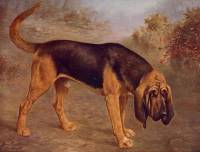 Bloodhound c 1900
Bloodhound c 1900
The Bloodhound is one of our oldest and most important dog breeds. This is because of his amazing ability to find man or beast by their scent. This trait has been selectively bred into him for centuries. Consequently many of today's working pure breed dog breeds have Bloodhound in their makeup. Today he is distinctly recognizable by his loose skin, his noble looks and his dignified expression.
History of the Bloodhound
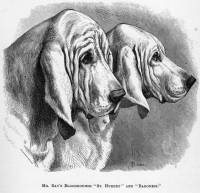 Bloodhounds c 1886
Bloodhounds c 1886
George Turberville in his 'Book of Venerie and Hunting' (1611 AD) stated that Bloodhounds were first brought to the Ardennes, which is now in South East Belgium, by the Trojans around the 8th Century BC. He called those which were black The Saint Hubert Hounds because they were bred in St Hubert's Abbey[2].
But the Bloodhound's documented history dates back around 1530 AD when there were wars between the English and the Scots about poaching cattle across the border. How Bloodhounds were employed to follow the scent of these poachers is fully described by Dr. Johannes Caius in 1570 AD (below). In 1607 AD, this hound's hunting habits were also described by Topsell who stated they could draw up their skin and frown like a sorrowful person!
The Bloodhound becomes a Pure Breed
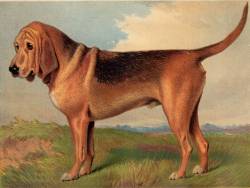 Bloodhound born 1874
Bloodhound born 1874
Usually hunted on a leash this dog is slow, carrying his head low as if dwelling on a doubtful scent, just to re-assure himself. His voice is full, deep in tone and melodious, as if to claim attention[3]. He was one of the pure breeds listed in the First English Stud Book published in 1874.
History of the Bloodhound in Australia
In the 1880's, Dr L L Smith introduced a dog and bitch Bloodhound to Melbourne but no further details are recorded[5]. Mr James Grice followed and brought Lufra 11 into Melbourne at the end of the 1890's, sending him to a station in the Riverina. Mr J W Cunningham of Kildary Station near Wagga Wagga then imported 'Dignity' who he mated to Lufra 11 and bred a few litters. Then Mr Sandeman imported 'Blazer'[6]. But no more Bloodhounds with verifiable pedigrees can be traced until the 1930's when Mr Doug Mummery became interested. A great admirer of the breed, in the 1950's he sailed to UK and purchased the 'best stock available' with which he established the Police Bloodhound Kennels in Melbourne where he bred under his 'Heatherglen' prefix[7].
The Bloodhound Today
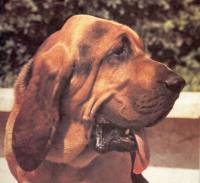 Bloodhound
Bloodhound
Today the Bloodhound is a noble looking dog with a dignified expression and relatively loose skin, with the characteristics of a typical hunting dog. He is a very powerful dog standing over more ground than is usual with hounds of other breeds. He has a somewhat reserved temperament, but never quarrelsome.
He has a narrow head with flattened sides, almost equal in width throughout its length, with almost parallel head planes with the length of foreface (muzzle) never shorter than the length of the skull, and a prominent occiput. The long foreface is deep and of even width throughout, with a square outline of the lips when seen in profile and from the front. The head is furnished with only a small amount of loose skin and the dog has large, open nostrils. The eyes are of medium size, neither sunken nor prominent. The ears are long, thin and soft to touch, set on low or dropped, and fall in graceful folds.
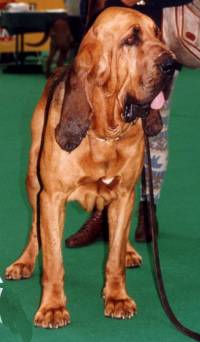 Bloodhound
Bloodhound
The neck is long, often with dewlap. The shoulders are muscular with a good lay of shoulder. The forelegs are straight and large, and have round bone with strong pasterns. The ribs are well sprung and the chest is well let down between forelegs forming a deep keel. Back is strong and the loins are deep and slightly arched. The first and second thighs very muscular with the hocks well let down, while the feet are strong and well knuckled up.
The tail of a hound is called a 'stern'. Although there is some hair underneath the tail, the tail itself should be long and thick, tapering to a point and shaped like a scimitar and carried high, especially when the dog is moving with its elastic free swinging style.
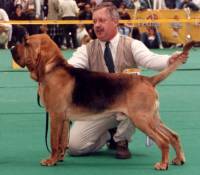 Bloodhound
Bloodhound
The coat is smooth short and weatherproof and comes in black and tan, liver and tan, red and tan and red. The darker coloured individual hairs are often mixed with lighter or badger coloured hair or are even sometimes flecked with white. A small amount of white is also allowed on the chest, feet or tip of tail.
The size with variance of an inch, a Bloodhound dog stands 26 inches high and the bitch 24 inches. They weigh around 90 - 80 pounds. However, larger Bloodhounds are preferred provided there is the correct combination of breed type and balance.
The Bloodhound (1570 AD)
In 1570, Dr. Johannes Caius called the type of scenting dog with a keen sense of smell Bloodhounds in his classification that was written in Latin and translated into English by A Fleming in 1576[1]. This is an important work because it clearly outlines in some detail just how the Bloodhound worked in different circumstances. The original translation is, in my opinion, too difficult to read to be printed only in its original form. So below is my interpretation in modern English.
Caius Part 1 - Hunting large game
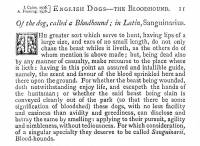 Caius Part 1
Caius Part 1
The greater sort which hunts, has large lips and ears of no small length. It chases not only the beast whilst alive but also when it is dead, finding it by the scent of the blood sprinkled here and there upon the ground.
Bloodhounds c 1800
This shows there is a wounded beast which is no doubt suffering. Maybe it has escaped the hands of the huntsman or maybe it has been slain and taken out of the park so that there is still some significant blood. These dogs can easily disclose these wounded or dead animals blood by smelling, tracking them with agility and nimbleness, without tediousness. For this singular specialty they deserve to be called, Bloodhounds.
Caius Part 2
Caius Part 2 - Tracking a Particular Poacher
However sometimes a piece of flesh may be stolen and cunningly conveyed away so that all appearance of blood is concealed. Yet this kind of dog is capable of tracking the poachers through long lanes and crooked tracks. No matter how much the poacher staggers under his load, the Bloodhound will track him without wandering away out of the limits of the land whereon these desperate thieves prepared their speedy passage.
Bloodhound 1874
Yea, the nature of these dogs is such, and so effectual is their foresight, that they can separate, and pick these thieves out from among other people whether they hide among crowds of people, lie hidden in wild woods, or in close and overgrown groves. Moreover, should they cross water, thinking that they would avoid the pursuit of the bloodhounds; these dogs will persevere in their pursuit, swimming through the stream, and when they arrive on the other bank, they hunt up and down, to and fro, from place to place, until they pick up the scent again.
Caius Part 3
Caius Part 3 - Tracking Runaway Poachers
Modern Bloodhound
And this is their practice, if they cannot find the escape route of the deed doers the first time, by tracking with diligence, as if this instinct was naturally instilled and poured into this kind of dogs. For they will not pause or take breath from their pursuit until such time as the thieves are apprehended and taken.
The owners of such hounds keep them enclosed in dark kennels in the daytime, and let them loose at night. The intent is that they might follow the felon in the evening and solitary hours of darkness, when such ill-disposed varlets are principally purposed to play their impudent pageants and imprudent pranks.
Caius Part 4
Caius Part 4 - Bloodhounds Acting as Leash Hounds
These Bloodhounds which follow people are not at liberty to range at will, except when they are following game. But when thieves make a speedy escape, the dogs are restrained and drawn back from running at random by a leash, the end of which the owner holds in his hand.
Modern Bloodhound
So the owner is led, guided and directed with such swiftness and slowness (whether he go on foot, or whether he ride on horseback) as he requires for the easy apprehension of these venturous deceitful scoundrels.
These Bloodhounds are also used on the border between of England and Scotland where cattle thieving is prevalent. They are taught and trained, first of all to hunt cattle and calves and afterwards to pursue such pestilent persons that take pleasure in such practices of stealing[1].
Bloodhounds World War One
This practice of training Bloodhound to track lost people, rogues and fugitives has remained through the centuries until present times, the picture on the right demonstrating their part in World War One[4].
References and Further Reading
[1] Dr John Caius, "Of Englishe Dogges: The Diuersities, the Names, the Natures, and the Properties", London, 1576, translated into English by Abraham Fleming, Pages 11-12. The work was originally published in Latin in 1570 as "Johannes Caius, De Canibus Britannicis".
[2] Edward C Ash, 'Dogs: Their History and Development' Volume ll Published by Houghton Mifflin Company Boston and New York Section Vlll Bloodhounds, Mastiffs, Bulldogs and Pugs. The Bloodhound pages 484 - 485.
[3] J.H.Walsh, under the name 'Stonehenge', 'The Dogs of the British Islands' (Fifth Edition) Published by 'The Field' Office, 346 Strand, W.C.London 1886. Part ll Book ll, 'Hounds and their Allies', Chapter ll, Modern Hounds Hunting by Nose. The Bloodhound Page 126
[4] Colonel E H Richardson, "Forty Years with Dogs" Published by Hutchinson & Co Ltd London E 4 (First Edition - no date) Chapter VI Police Dogs, 'Tracking Bloodhounds' P.105 - 132
[5] T.W.Tyzack and C.S. Turner "Tyzack's Annual" published by the Victorian Poultry and Kennel Club 1912, printed by Bellmaine Bros., Printers 66 - 70 Flinders Lane Melbourne Australia P. 82
[6] W. Beilby 'The Dog in Australasia' published George Robertson & Company in 1897 Chapter on the Dandie Dinmont Terrier Pages 110 - 111.
[7] Mike Jennings, "The History of Purebred Dogs in Australia" The Bloodhound published by OzDog Newspaper 1997 Page 52 - 53